By Mr. Saint
I love this time of year. The leaves are changing, the unmistakable scent of pumpkin spice is in the air, people are looking for scary movies to stream. There’s just something about late Fall that is filled with suspense, like the world stands at the edge of something momentous, waiting for a signal. If you’re an avid board gamer, you might be looking to capture some of the spirit of the season on your table. Thankfully, Fantasy Flight Games (FFG) has a line of games that are perfect for just such an occasion. In this blog post, we’ll take a look at three games from FFG’s Arkham Horror Files line of products and discuss whether they might be a good fit for your group.
But first, what are the Arkham Horror Files? The Arkham Horror Files game series comprise a shared universe of games, loosely based on the works of H.P. Lovecraft. More pulp noir meets Supernatural than true cosmic horror, these games nonetheless borrow heavily from the Cthulhu mythos for their theming, settings, and characters. In most Arkham Horror Files games, the players take on the role of a group of investigators tasked with understanding, and ultimately stopping the arrival of the Ancient Ones (malevolent entities from outside our dimension, beyond human understanding). To that end, players will have to cooperatively investigate various cult activities, fend off supernatural monsters and phenomena, and find a way to keep our reality safe. Some of my favorite gaming moments are from this series.
Below, we’ll look at three games from the Arkham Horror Files series, give a brief overview of each, explain what makes each one great, and why you might want to give them a pass.
Mansions of Madness 2nd Edition
At its core, Mansions of Madness is an app-assisted, scenario driven, dungeon crawler. Players will move through the game map (often a mansion, but sometimes a small town, a parade, or any of several other settings), trying to piece together what is going on. Depending on the scenario, you might be investigating a murder, looking into a strange disappearance, helping a university professor perfect a new type of drug, or just trying to escape from a town before the locals find you.
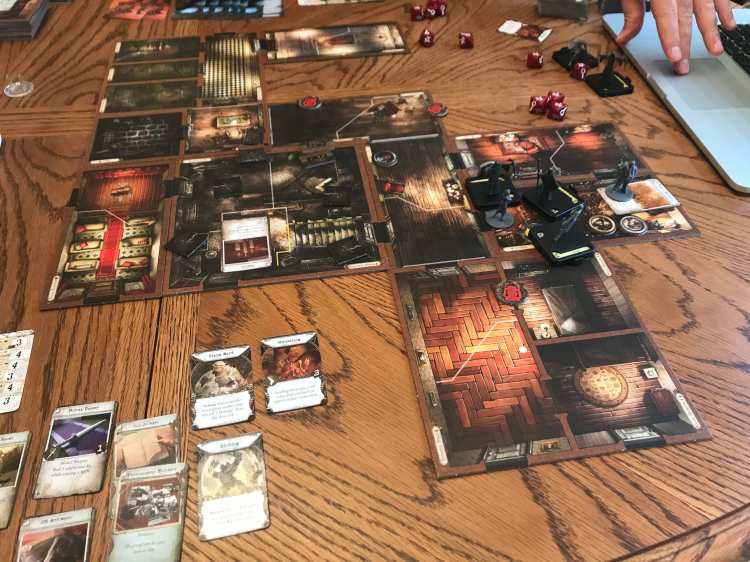
Why you might love it:
Mansions of Madness is a deeply thematic narrative experience. It is the game that most makes me feel like an actual Arkham investigator, putting me in their shoes at the ground level as I try to make sense of the strange happenings in each scenario. Many Mansions of Madness scenarios feature an actual mystery that needs to be solved. And the app helps manage the grunt work, generating the map in piecemeal fashion as the players’ characters move about. This integrated setup model means that Mansions of Madness boasts the shortest setup time of the games we’re talking about today (assuming proper organization). From taking the game off the shelf to playing usually takes no more than three minutes.
Because of the way the app randomizes the scenarios each time you play, Mansions of Madness is the perfect game to play occasionally, even without expansions. If you have a large game collection and can only see playing an Arkham Horror Files game once every few months, this would be my pick, even without investing in additional expansions.

Why you might not:
Let’s get the big reason out of the way: Mansions of Madness uses an integrated app. If you don’t like apps in your board games, you won’t like Mansions of Madness. The app is well done, doing some heavy lifting regarding setup time and the game’s admin. But there is no way to play Mansions of Madness 2nd Edition without the app. So if that’s a deal breaker, you’ll have to look elsewhere for your mythos fix.
Properly organized, Mansions of Madness takes up a lot of space (see picture below). Part of ensuring minimal downtime for a session of Mansions of Madness means having a storage solution for the many miniatures that come with the game and it’s expansions. Nothing kills the mood more than spending ten minutes trying to find that one Priest of Dagon mini during the pivotal point of a scenario. As such, organization is essential, and if you want to use the minis (we usually play with them), most storage solutions take up a fair bit of space. If space is at a premium for you, you might want to give Mansions of Madness a pass.
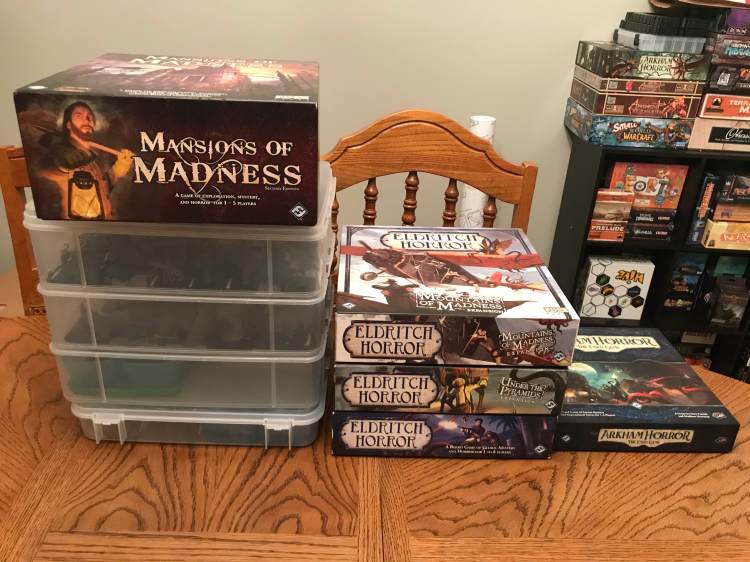
Arkham Horror: the Card Game
Arkham Horror: the Card Game (AH:LCG for short) is a campaign-based, scenario driven experience, with elements of resource and hand management. It is what is known as a “living card game”. This means that content is released on a regular schedule, constantly evolving the game with new characters, scenarios, and of course, more cards! Because AH:LCG is a campaign game, the stories it tells are more overarching, compared to Mansions of Madness or Eldritch Horror. Rather than solving a mystery in a single setting, the AH:LCG has players working together through a series of interconnected scenarios (usually 8 per a Mythos cycle).
Each player will take on the role of an investigator, this time represented by a deck of cards which they will assemble before starting a campaign.
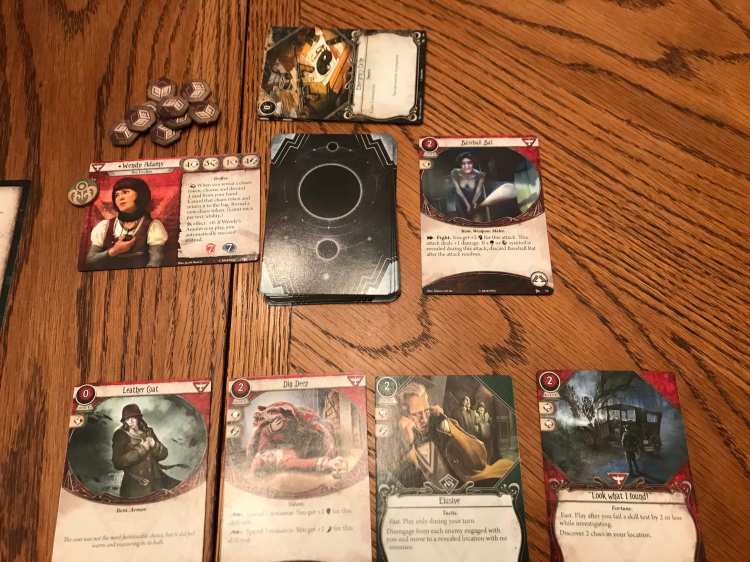
Why you might love it:
The AH:LCG is compact. Because everything is represented by cards (and a handful of tokens), it’s easy to store and transport. It’s compact in another way as well, with each scenario taking approximately an hour to an hour and a half (contrasted with Mansions of Madness or Eldritch Horror, which can easily take 2-3 hours or more per a session). This makes AH:LCG the perfect game to get our Mythos fix in during a weeknight!
Because AH:LCG is set up as a series of campaigns, there is a sense of permanence to your actions. Characters gain XP in between scenarios, which they can use to purchase more powerful cards for their decks. Even better, many of the players’ choices, successes, and failures have an impact from scenario to scenario. If your investigator suffers mental trauma early in a campaign, that’s something your character will have to deal with for the remainder of that campaign’s scenarios. Between the deck building, character progression, and persistent consequences, AH:LCG allows for players to have the most ownership over their investigators, as each has the potential to be totally unique.
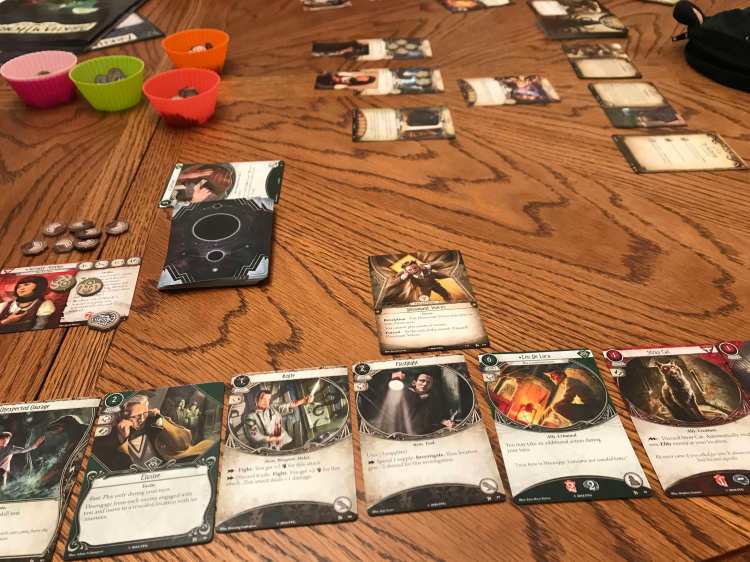
Why you might not:
Arkham Horror: the Card Game is expensive, even by hobby board game standards. The Core Set (which comes with 3 scenarios), has an MSRP of $45 USD. If you really get into deckbuilding, one of the central replayability hooks of AH:LCG, you’re going to want two Core Sets ($90 USD MSRP). From there, each new mythos cycle will set you back $120 USD (one big box expansion and six mythos packs). That’s $210 for a pretty standard “introductory” collection for Arkham Horror: the Card Game (11 total scenarios). Compared to Mansions of Madness, you could get the base game and two large box expansions for a similar price (a bunch of minis, and 10 scenarios with randomly generated maps/plot elements for high replayability). $210 would buy you the base game of Eldritch Horror, all the small box expansions (4), and a large box expansion of your choice (enough content for practically endless games of Eldritch Horror).
The amount of replayability that AH:LCG has is directly related to the amount you enjoy the deckbuilding aspect of the game. The story beats of each campaign don’t change very significantly from one campaign to another (from what I’ve seen, we don’t own the entirety of the LCG), so the joy of replaying specific scenarios/campaigns rests mostly with testing out new characters and cards. If deckbuilding doesn’t interest you, the AH:LCG is mostly a one-and-done system, with limited reason to replay a campaign once completed. If you’re someone who plays your games a lot, and you aren’t particularly interested in the deckbuilding aspect, I’d steer clear of Arkham Horror: the Card Game.
Eldritch Horror
Eldritch Horror is what is typically known as an adventure game. Your group of investigators will travel around the globe, working together to solve a series of Mysteries before the Ancient One can consolidate their power and irreparably damage our reality. In true adventure game format, much of the game is going to specific locations and having encounters; snippets of storytelling that form an emergent narrative as you play through a session.
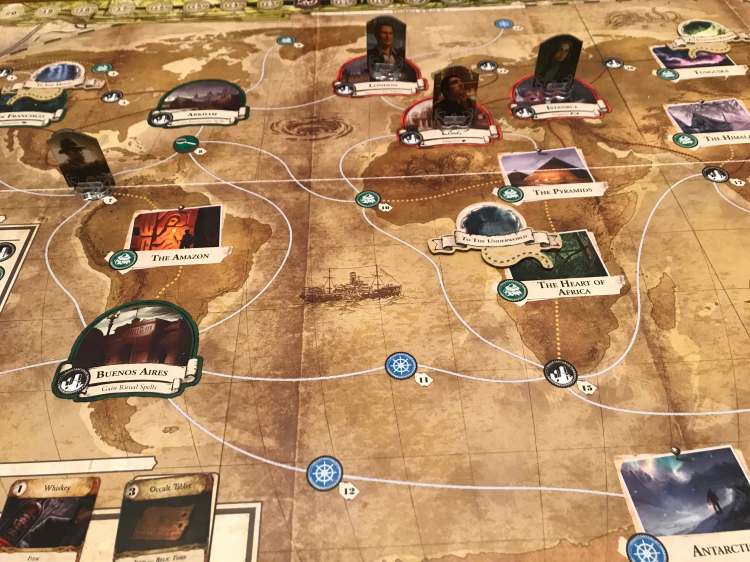
Why you might love it:
Of the three games that are the subject of this article, Eldritch Horror offers the most variety from game to game by far. Each game, you’ll randomly pick three of the Ancient One’s Mysteries to determine the goals for the game (out of six possible mysteries in most cases). This gives each Ancient One significant replayability. Similarly, there are tons of Investigators to try, Prelude cards to use to change game setup (Prelude cards were added in expansions, they are not present in the base game), and dozens of Encounters to experience. Every game of Eldritch Horror is unique!
Nothing exemplifies the variety that Eldritch Horror brings to the table more than the condition cards. Each type of condition card says the same thing on the front, but all of the backs are different, and players can’t look at the back of their card until the game instructs them to do so. For example, if you contract a disease during the course of your investigation, you won’t know if it’s an alien plague or the common cold until the game tells you to flip the card. If you get rid of your disease condition before it triggers, you might never know! The condition cards are a big part of forming the emergent narrative that Eldritch Horror is so well known for.
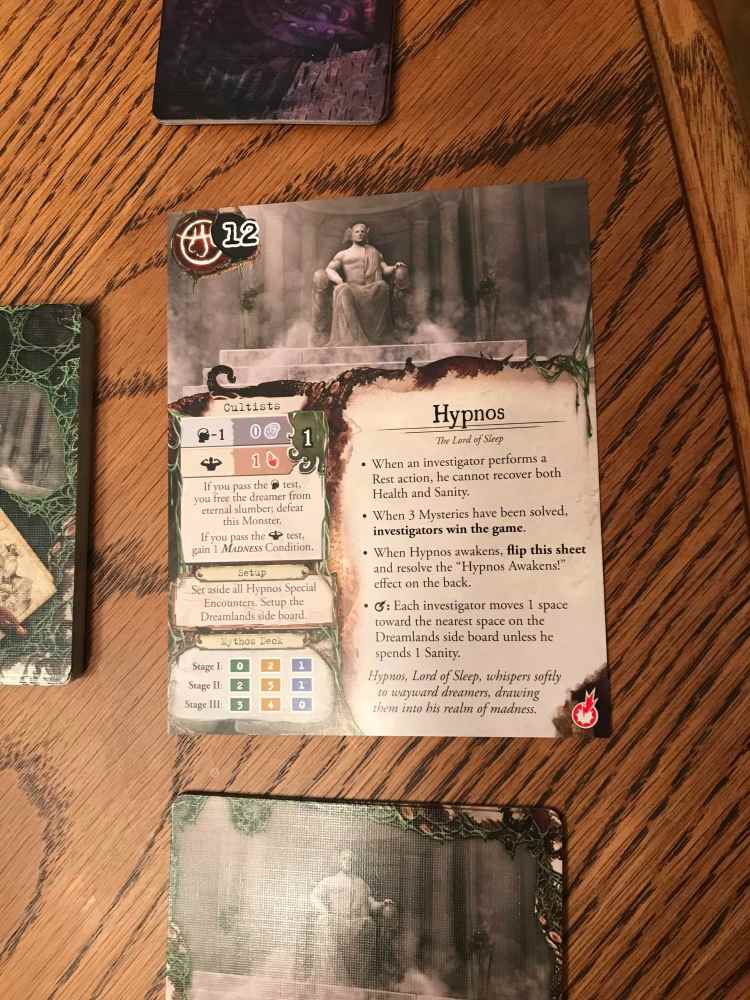
Why you might not:
Eldritch Horror suffers a bit from Fantasy Flight’s expansion-based business model. The core game feels incomplete without the first expansion, Forsaken Lore. It’s difficult to look at the content that Forsaken Lore adds to the game and come to any conclusion other than that this was content pruned from the base game in order to fuel first expansion purchases by early adopters. If this leaves a bad taste in your mouth, Eldritch Horror probably is not the game for you. Because Eldritch Horror thrives on the variety it offers, some amount of expansion purchases are essential to bolster the game’s content.
We mentioned it above, but Eldritch Horror provides an emergent narrative experience, as opposed to the guided narrative of the LCG or Mansions of Madness. If you would rather be told a story instead of creating your own, Eldritch Horror is a worse choice than the other two games we’ve discussed in this article. And while the emergent narrative does offer some great storytelling moments, it sometimes breaks down into silliness in a way that is unlikely to occur in the other two games. This can be immersion breaking if you can’t handle a little levity with your Lovecraft.
If you liked this post, please follow us on Twitter, Instagram, or Facebook to get notified when new content goes live on the website.
One thought on “An Introduction to the Arkham Horror Files”